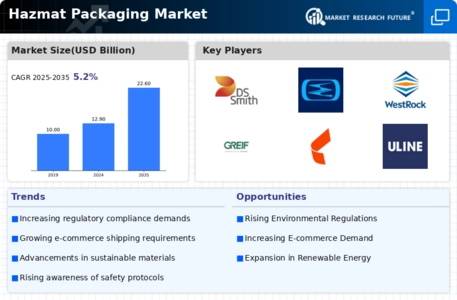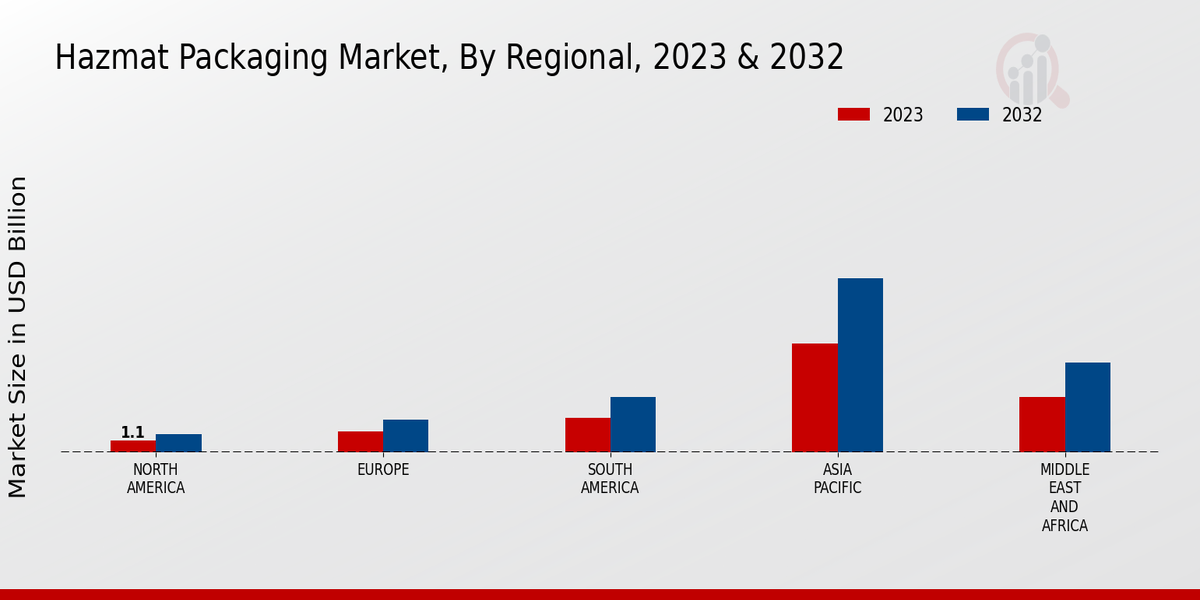Regulatory Compliance
The Global Hazmat Packaging Market Industry is significantly influenced by stringent regulatory frameworks governing the transportation of hazardous materials. Governments worldwide, including the United States Environmental Protection Agency and the European Chemicals Agency, enforce regulations that mandate specific packaging standards to ensure safety during transit. These regulations compel manufacturers to invest in compliant packaging solutions, thereby driving market growth. As of 2024, the market is valued at 12.9 USD Billion, reflecting the increasing emphasis on safety and compliance in hazardous material handling. This trend is expected to continue as regulations evolve, further shaping the industry's landscape.
Market Growth Projections
The Global Hazmat Packaging Market Industry is poised for substantial growth, with projections indicating a market value of 12.9 USD Billion in 2024 and an anticipated increase to 22.6 USD Billion by 2035. This growth trajectory suggests a robust demand for hazmat packaging solutions driven by various factors, including regulatory compliance, increased transportation activities, and technological advancements. The projected CAGR of 5.22% from 2025 to 2035 further underscores the industry's potential for expansion. These figures reflect the ongoing evolution of the market, as stakeholders adapt to emerging trends and challenges in hazardous material handling.
Technological Advancements
Technological innovations play a crucial role in shaping the Global Hazmat Packaging Market Industry. Advancements in materials science and engineering have led to the development of more durable and efficient packaging solutions that enhance safety and compliance. For example, the introduction of smart packaging technologies allows for real-time monitoring of hazardous materials during transit, ensuring adherence to safety standards. These innovations not only improve the reliability of hazmat packaging but also drive market growth as companies seek to leverage technology to enhance their operations. The ongoing evolution in packaging technology is likely to remain a key driver in the coming years.
Growing Chemical Production
The rise in global chemical production is a pivotal driver for the Global Hazmat Packaging Market Industry. As industries expand and the demand for chemicals increases, the need for safe and reliable packaging solutions becomes paramount. For instance, the chemical sector is projected to witness substantial growth, necessitating advanced packaging that meets safety standards. This surge in production is anticipated to contribute to the market's valuation, which is expected to reach 22.6 USD Billion by 2035. Consequently, manufacturers are likely to innovate and enhance their packaging solutions to cater to this growing demand, thereby fostering market expansion.
Rising Environmental Concerns
Increasing environmental awareness is influencing the Global Hazmat Packaging Market Industry, as stakeholders seek sustainable packaging solutions. The push for eco-friendly materials and practices is prompting manufacturers to develop packaging that minimizes environmental impact while ensuring safety. This trend aligns with global sustainability goals, as companies strive to reduce their carbon footprint. The market's growth is likely to be bolstered by the demand for sustainable hazmat packaging solutions, reflecting a broader shift towards environmentally responsible practices in hazardous material handling. As such, the industry is expected to adapt to these changing consumer preferences and regulatory pressures.
Increased Transportation Activities
The Global Hazmat Packaging Market Industry is propelled by the escalation of transportation activities across various sectors. With the rise in e-commerce and global trade, the movement of hazardous materials has surged, necessitating robust packaging solutions to mitigate risks during transit. This trend is particularly evident in sectors such as pharmaceuticals and chemicals, where the safe transport of hazardous substances is critical. The market is projected to grow at a CAGR of 5.22% from 2025 to 2035, indicating a sustained demand for effective hazmat packaging solutions that ensure compliance and safety during transportation.






















